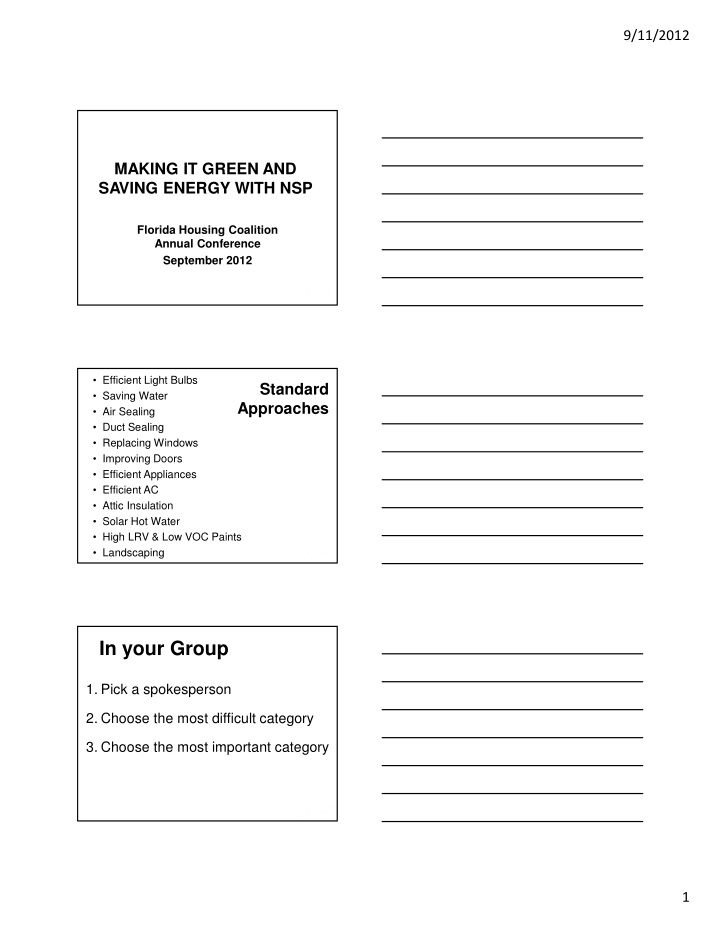



9/11/2012 MAKING IT GREEN AND SAVING ENERGY WITH NSP Florida Housing Coalition Annual Conference September 2012 • Efficient Light Bulbs Standard • Saving Water Approaches • Air Sealing • Duct Sealing • Replacing Windows • Improving Doors • Efficient Appliances • Efficient AC • Attic Insulation • Solar Hot Water • High LRV & Low VOC Paints • Landscaping In your Group 1. Pick a spokesperson 2. Choose the most difficult category 3. Choose the most important category 1
9/11/2012 • Efficient Light Bulbs Standard • Saving Water Approaches • Air Sealing • Duct Sealing • Replacing Windows • Improving Doors • Efficient Appliances • Efficient AC • Attic Insulation • Solar Hot Water • High LRV & Low VOC Paints • Landscaping How to Make it Easier 1. Prioritize 2. Make it Prescriptive 3. Standardize Specifications 4. Train Contractors 5. Inspect, Inspect, Inspect Prioritize • Choose from the list • Focus on the occupants • Use “Science” when possible –e.g. Have an energy auditor help you to prioritize energy conservation strategies 2
9/11/2012 Be Prescriptive • Think in terms of “Standard House Types” – Simple One Story, 1,000 to 1,500 SF? • Standardize of work by house type – Insulation & Air Sealing – Ventilation – HVAC – Accessibility Specifications • Specifications are available in the HUD NSP Toolkit website • Go to –hudnsphelp.info – Click on Find a Resource – Choose Toolkits NSP Resource Exchange Toolkits 3
9/11/2012 COMMODE, REPLACE, 1.28 - GPF Install a 1.28 GPF close coupled, white, vitreous china commode such as an American Standard FloWise Compact Cadet 3 EL 2403.128, or any commode tested through the latest "Maximum Performance" (MaP) testing that has shown to score 800 or better on the MaP Flush Performance test (grams of solid waste removed in a single flush). See the following link for the most recent MaP report. www.map-testing.com Include a manufacturer's approved plastic or pressed wood white seat, supply pipe, shut-off valve, and wax seal. AIR-SEAL BUILDING ENVELOPE Seal all accessible cracks, gaps and holes in the building envelope (the barrier between the indoor conditioned space and the outside) with low- VOC caulk (if <1/4") or expanding foam (if > 1/4"). Seal all top plate and bottom plate penetrations. If the foundation masonry wall is open core concrete block seal the tops of the block with expanding foam. Seal all penetrations created by plumbing, gas lines, electrical boxes and outlets. Seal large accessible gaps around windows between house framing and window frame - use special care on large sliding-glass doors and vinyl- framed windows: do not use expansive foam on these. Take care to seal all joints without excess sealant. Seal any gaps in the building envelope adjacent to flues with carefully cut to fit sheet metal that is securely fastened to framing sealing all seams and gaps with fire rated caulk. Seal recessed light fixtures in ceilings that are part of the building envelope and are not rated for insulation contact with an airtight box made of drywall sealed to the ceiling. Seal IC rated recessed fixtures with caulk. Seal any entries to attic space using weather-stripping on attic doors or hatches. Air sealing must be done prior to the installation of insulation. Train Contractors 4
9/11/2012 Train Contractors Train Contractors Inspect, Inspect, Inspect • Each of us performs better when we’re held accountable • e.g. Insulation and air sealing mistakes are better identified before they’re hidden • Write inspection stages into your specifications 5
9/11/2012 Inspect, Inspect, Inspect • Consider using your Energy Auditor to do energy conservation related inspections • Validate the performance of ventilation systems (commissioning) • Call for specific products, allow recommendations for substitutions, check what was installed Contact Information Armand C Magnelli Livable Housing, Inc. 975 Upland Road York, PA 17403 717 676 0517 amagnelli@livablehousing.com 6
Recommend
More recommend